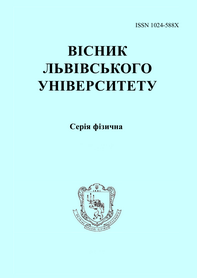Visnyk of the Lviv University. Series Physics
60 (2023) ñ. 144-156
DOI: https://doi.org/10.30970/vph.60.2023.144
Structural and Electronic Properties of the LiH3(SeO3)2 Crystals
M. Onysko, O. Bovgyra, M. Kovalenko, P. Yakibchuk
|  |
(íå ìåíøå 1800 çíàê³â)
In this article, theoretical first-principles investigations were conducted on the structural and electronic properties of ferroelectric crystals LiH3(SeO3)2. Structural models of the crystal were optimized using the Broyden-Fletcher-Goldfarb-Shanno (BFGS) algorithm. Density functional theory (DFT) calculations were performed using various approximations for exchange-correlation interactions: GGA (PBEsol), GGA (PBE), GGA(WC), and HSE06. Additionally, semi-empirical pairwise dispersion corrections for van der Waals interactions (DFT+D) were considered.
The optimized structures were obtained using \mbox{different} approximations for exchange-correlation potentials. GGA(PBE--Grimme) and GGA(WC) approximations yielded results consistent with experimental data, deviating by less than 1\%. The electronic band structures, calculated using various exchange-correlation approximations, showed weak dispersion in the \textit{k}-space, except for lines directed to A and \Gamma points of the Brillouin zone. The valence band maximum was localized at point A (\textminus0,5, 0, 0,5), while the conduction band minimum was at point E (\textminus0,5, 0,5, 0,5), indicating the compound's indirect bandgap nature. The analysis of calculations using different approximations for the exchange-correlation potential suggests that the fundamental band gap width of the LiH3(SeO3)2 crystal at 0 K is approximately 5.7 eV.
Analysis of partial contributions of individual orbitals to the electronic density of states revealed that the valence band states were formed by hybridized \textit{p}-orbitals of oxygen ions with \textit{s-p} orbitals of Se ions, while the conduction band states were associated with \textit{sp}-orbitals of Se ions hybridized with \textit{p}-orbitals of oxygen ions. Furthermore, the spatial distribution of charge density \rho(r) was visualized, providing insights into the chemical bonding in this crystal. The calculations showed strong hydrogen bonds parallel to the \textit{c}-plane, perpendicular to the polar direction.
The results provided valuable insights into the compound's electronic band structure, charge density distribution, and bonding characteristics, shedding light on its unique ferroelectric properties and \mbox{potential} applications.
Full text (pdf)
References
- W. Shockley, H. J. Queisser, J. Appl. Phys. 32, 510 (1961). doi: 10.1063/1.1736034.
- R. Pepinsky, K. Vedam, Phys. Rev. 114, 1217 (1959). doi: 10.1103/PhysRev.114.1217.
- K. Vedam, Y. Okaya, and R. Pepinsky, Phys. Rev. 119, 1252 (1960). doi: 10.1103/PhysRev.119.1252.
- X. Yang, C.-X. Shan, Y.-J. Lu, X.-H. Xie, B.-H. Li, S.-P. Wang, M.-M. Jiang, and D.-Z. Shen, Opt. Lett. 41, 685 (2016). doi: 10.1364/OL.41.000685.
- A. V. Oli, Z. Li, Y. Chen, and A. Ivaturi, ACS Appl. Energy Mater. 5, 14669 (2022). doi: 10.1021/acsaem.2c01560.
- K.-S. Lee, J. S. Kim, and Y. S. Yu, J. Korean Phys. Soc. 42, S1030 (2003).
- S. J. Clark, M. D. Segall, C. J. Pickard, P. J. Hasnip, M. I. Probert, and K. Refson, Z. Kristallogr. 220, 567 (2005). doi: 10.1524/zkri.220.5.567.65075.
- D. Vanderbilt, Phys. Rev. B 41, 7892 (1990). doi: 10.1103/PhysRevB.41.7892.
- J. P. Perdew, K. Burke, and M. Ernzerhof, Phys. Rev. Lett. 77, 3865 (1996). doi: 10.1103/PhysRevLett.77.3865.
- J. P. Perdew, A. Ruzsinszky, G. I. Csonka, O. A. Vydrov, G. E. Scuseria, L. A. Constantin, X. Zhou, and K. Burke, Phys. Rev. Lett. 100, 136406 (2008). doi: 10.1103/PhysRevLett.100.136406.
- Z. Wu and R. E. Cohen, Phys. Rev. B 73, 235116 (2006). doi: 10.1103/PhysRevB.73.235116.
- A. D. Becke, J. Chem. Phys. 98, 5648 (1993). doi: 10.1063/1.464913.
- C. Lee, W. Yang, and R. G. Parr, Phys. Rev. B 37, 785 (1988). doi: 10.1103/PhysRevB.37.785.
- J. Heyd and G. E. Scuseria, J. Chem. Phys. 124, 219906 (2006). doi: 10.1063/1.2204597.
- S. Grimme, J. Comput. Chem. 27, 1787 (2006). doi: 10.1002/jcc.20495.
- A. Tkatchenko and M. Scheffler, Phys. Rev. Lett. 102, 073005 (2009). doi: 10.1103/PhysRevLett.102.073005.
- A. Ambrosetti, A. M. Reilly, R. A. DiStasio, and A. Tkatchenko, J. Chem. Phys. 140, 18A508 (2014). doi: 10.1063/1.4865104.
- C. G. Broyden, IMA J. Appl. Math. 6, 222 (1970). doi: 10.1093/imamat/6.3.222.
- R. Fletcher, Comput. J. 13, 317 (1970). doi: 10.1093/comjnl/13.3.317.
- D. Goldfarb, Math. Comp. 24, 23 (1970). doi: 10.1090/S0025-5718-1970-0258249-6.
- D. F. Shanno, Math. Comp. 24, 647 (1970). doi:10.1090/S0025-5718-1970-0274029-X.
- R. Pepinsky, K. Vedam, Phys. Rev. 114, 1217 (1959). doi: 10.1103/PhysRev.114.1217.
- A. R. Lim, J. Mol. Struct. 1049, 263 (2013). doi: 10.1016/j.molstruc.2013.06.050.
- R. Tellgren, R. Liminga, J. Solid State Chem. 4, 255 (1972). doi: 10.1016/0022-4596(72)90114-4.
- J. K. Mohana Rao, M. A. Viswamitra, Acta Cryst. B 27, 1765 (1971). doi: 10.1107/S056774087100476X.
- S. Chomnilpan, R. Liminga, and R. Tellgren, Acta Cryst. B35, 2692 (1979). doi: 10.1107/S0567740879010219.
- M. S. Lehmann, F. K. Larsen, Acta Chem. Scand. 25, 3859 (1971).
- L. C. Straub, M. S. Wickleder, B. Rasche, Inorg. Chem. 61, 8, 3641–-3648 (2022). doi: 10.1021/acs.inorgchem.1c03734.
- V. Kapustianyk, Yu. Eliyashevskyy, O. Vira, B. Turko, Z. Czapla, Opt. Mater., to be published.
- T. Miyoshi, H. Mashiyama, T. Asahi, H. Kimura, and Yu. Noda, J. Phys. Soc. Jpn. 80, 044709 (2011). doi: 10.1143/JPSJ.80.044709.

